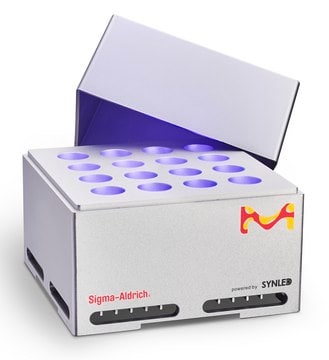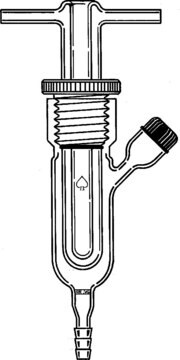Z744078
395 nm Light source
Synonim(y):
395nm LED Light Module
About This Item
Polecane produkty
Powiązane kategorie
Opis ogólny
Cechy i korzyści
- Modular design allows for use with a variety of wavelengths 365nm – 450nm
- 360 degree reflective environment maximizes surface area photon capture
- Light shield interlock prevents user exposure to harmful light rays
- Interactive touch screen controls reaction parameters
- Intertek ETL, CE, and CB approved
- User defined parameters including temperature, light intensity, fan speed and stirring
- Auto stop, pause and reset options
- Supports vial sizes gc, 4, 8, 20, 40 ml
- Temp feedback using a k-type thermocouple
Inne uwagi
Certyfikaty analizy (CoA)
Poszukaj Certyfikaty analizy (CoA), wpisując numer partii/serii produktów. Numery serii i partii można znaleźć na etykiecie produktu po słowach „seria” lub „partia”.
Masz już ten produkt?
Dokumenty związane z niedawno zakupionymi produktami zostały zamieszczone w Bibliotece dokumentów.
Produkty
The application of radical chemistry towards organic synthesis is well-developed and wide-reaching, though often hampered by a dependence on toxic radical initiators.
Zastosowanie chemii rodnikowej w syntezie organicznej jest dobrze rozwinięte i szeroko zakrojone, choć często utrudnia je zależność od toksycznych inicjatorów rodnikowych.
Learn about the applications of chiral oxazaborolidinium ions (COBIs) as Lewis acid catalysts in different asymmetric reactions such as cyclopropanation, epoxidation, and radical reactions along with details of their catalytic action.
This article details the latest progress in synthesizing alkylsulfonyl fluorides through different approaches that utilize photoredox catalysis, electrocatalysis, transition-metal catalysis, and organocatalysis. The alkylsulfonyl fluorides thus prepared could be utilized further in sulfur(VI) fluoride exchange (SuFEx) click reactions.
Nasz zespół naukowców ma doświadczenie we wszystkich obszarach badań, w tym w naukach przyrodniczych, materiałoznawstwie, syntezie chemicznej, chromatografii, analityce i wielu innych dziedzinach.
Skontaktuj się z zespołem ds. pomocy technicznej






